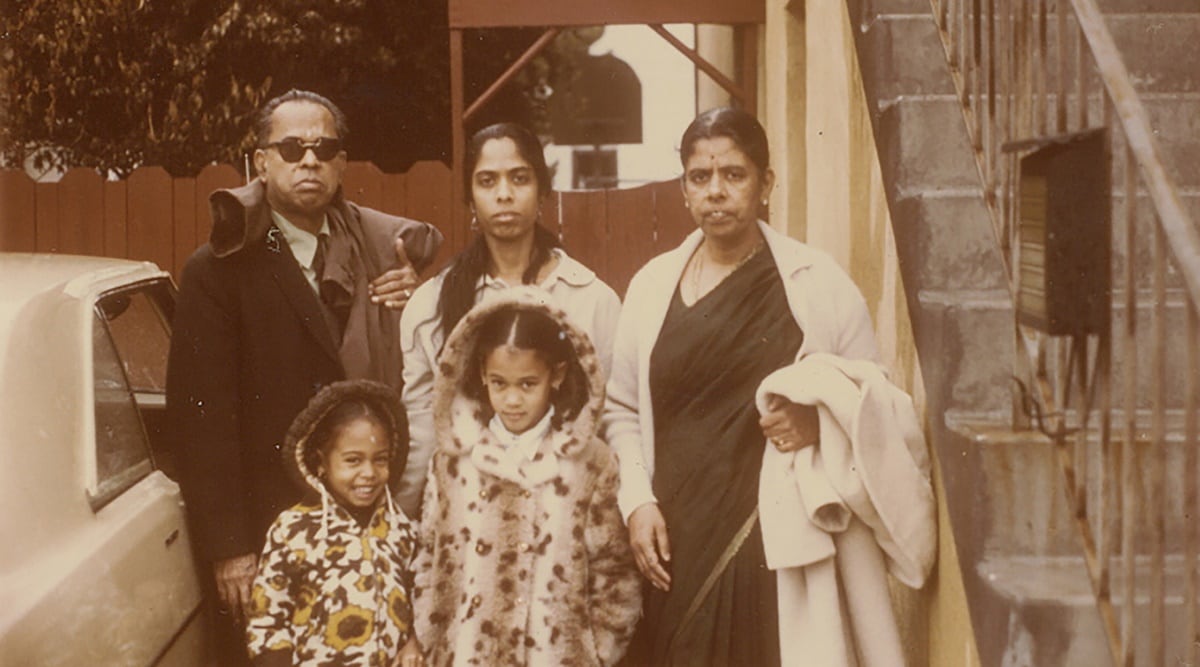 In an image provided by the Joe Biden campaign, Kamala Harris, front center, with, from left, her grandfather, P.V., sister, Maya, mother, Shyamala Gopalan, and grandmother, Rajam Gopalan, in 1972. (Joe Biden campaign via The New York Times)
In an image provided by the Joe Biden campaign, Kamala Harris, front center, with, from left, her grandfather, P.V., sister, Maya, mother, Shyamala Gopalan, and grandmother, Rajam Gopalan, in 1972. (Joe Biden campaign via The New York Times) By Ravi Kalia
During his North Carolina political rally earlier this month, President Donald Trump’s ad hominem and sexist attack went after Democratic Vice President nominee Kamala Harris: “She could never be the first woman president. . . That would be an insult to our country.”
Constitutional niceties and the 19th Amendment — which cemented a promise into the US Constitution a 100 years ago that “the right of citizens of the United States to vote shall not be denied or abridged by the United States or by any State on account of sex” — are irrelevant to him.
But it isn’t that difficult to accept Senator Kamala Harris as simply a successful American daughter of immigrant parents in multiracial America.
Shyamala Gopalan, Kamala’s mother, was born in Chennai (Madras) and arrived in Berkeley in 1959, aged 19, after graduating from all-women’s Lady Irwin College in Delhi, named after Lady Dorothy Irwin, the wife of Viceroy Irwin, a British conservative politician of the 1930s: Lady Dorothy had set the college curriculum to train Indian girls skills in home-making, hygiene, childcare, and how to be assets to their husbands, and society. Instead, Shyamala elected to do graduate studies in America.
Donald Harris, Kamala’s father, came to Berkeley to study economics from the newly independent Jamaica in 1963, the Caribbean nation that had been the gateway to the slave trade in North America. He was also of mixed racial ancestry. In their respective countries, both had witnessed the oppression of British colonial rule. They discovered each other in protest marches against racial injustice and inequality, fell in love and married without much fanfare in 1963.
Shyamala’s is a quintessentially American story, with a happy twist. In 1948, the California Supreme Court had overturned the state’s anti-miscegenation statutes that had been on the books since the mid-19th century (Pérez v. Sharp), and, although Shyamala’s family for financial reasons wasn’t able to attend the wedding, they warmly extended their blessings to the newly-weds. Shyamala’s Delhi-based brother, Balachandran, who himself married a Mexican woman, has described his parents as “progressive”. On her website, Senator Harris has affirmed her dual roots: South Asian and African-American.
To acknowledge one side of the lineage is not to deny the other; moreover, both African-Americans and South Asians are highly diversified diasporas that have added to the changing demographics of America, which Jesse Jackson described as a “Rainbow Coalition” in his two presidential bids in 1984 and 1988. It would take another 30 years for the improbable Kamala Harris to emerge as a vice presidential candidate of that idea.
In her virtual acceptance speech on August 19, Harris acknowledged the debt to African-American women who fought for equality: “Mary Church Terrell, Mary McCleod Bethune, Fannie Lou Hamer and Dane Nash, Constance Baker Motley and Shirly Chisholm.” She added: “There’s another woman, whose name isn’t known, whose story isn’t shared… my mother — Shyamala Gopalan Harris.”
Shyamala Gopalan Harris was born in 1938 — in the crucible decade before India’s independence in 1947. By the time she was 10 years old, she had witnessed one million dead as communal riots bloodied Indian independence and left 14 million refugees, Hindus and Muslims, in India and Pakistan. And she saw Gandhi’s assassination by a hothead who disapproved of Mahatma’s accommodation of the Muslims. And she had watched Kasturba Gandhi, Kamala Nehru, Sarojini Naidu, Sucheta Kripalani, and other Indian women march lockstep with Gandhi in his satyagraha movement. Kamala was only a toddler when Shyamala took her in a stroller to protest marches in Berkeley; she was 18 when Richard Attenborough’s epic film Gandhi (1982) famously portrayed Indian women providing first-aid to bleeding men beaten by police batons in India’s struggle against the British.
When she arrived in Berkeley in 1959, Jim Crow laws, a byproduct of colonial America, were still in force. Earlier in 1955, Emmet Till had been lynched in Mississippi; and the same year America saw the Montgomery, Alabama, Bus Boycott, a 13-month-long political and social protest campaign against the policy of racial segregation on the public transit system of the city, and arguably the beginning of the civil rights movement. African American seamstress Rosa Parks was arrested for refusing to give up her seat to a white man on a city bus, and Martin Luther King, Jr. was thrust into the leadership role of the budding civil rights movement. In 1959, MLK would travel to India to study Gandhi’s satyagraha as a non-violent strategy for the American civil rights movement.
Shyamala Gopalan Harris and Donald Jasper Harris were born in 1938 in India and Jamaica, respectively, when their countries were still under British rule; and that they witnessed corrosive effects of racism in their countries; and that they met in Berkeley just when the civil rights movement was unfolding. At the heart of colonial rule was racism. The African-American experience in Shyamala’s adopted country and the Indian experience in her birth country are intertwined against racism: Together, they make Senator Harris quintessentially American.
But the American president has a deficit in American history.
Kalia is professor of history at the City College of New York and author of, most recently, Pakistan’s Political Labyrinths: Military, Society and terror (Routledge, 2016)
📣 The Indian Express is now on Telegram. Click here to join our channel (@indianexpress) and stay updated with the latest headlines
For all the latest Opinion News, download Indian Express App.